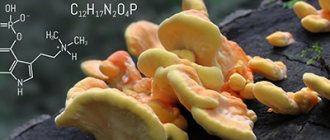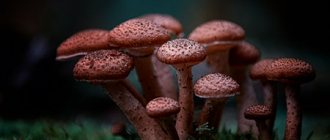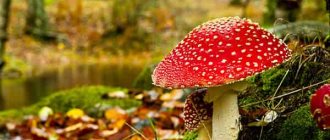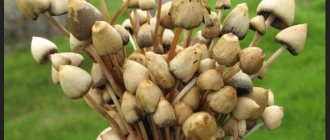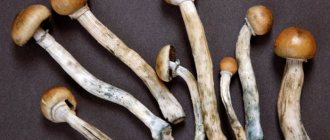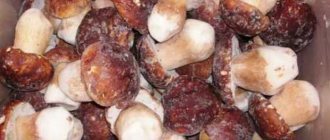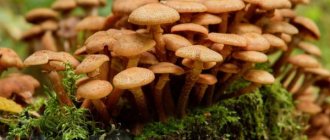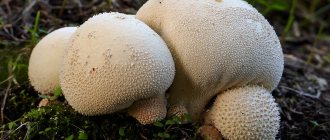Psilocybin belongs to a group of powerful psychedelic drugs. It is found in the stems of hallucinogenic mushrooms and is comparable in effect to LSD. In ancient times, this substance was used by shamans in Africa and India in various rituals. In the modern world, psilocybin is officially recognized as a drug.Therefore, storing, growing and selling such mushrooms is prohibited.
What is psilocybin?
Psilocybin, or N-dimethyltryptamine, is a psychoactive substance extracted from dried mushrooms or synthesized artificially in the laboratory.
In its pure form, psilocybin is a white powder. Hallucinogenic mushrooms are similar in appearance to typical poisonous mushrooms - because of this, a person can get severe poisoning if they are collected incorrectly.
The typical appearance of mushrooms: a thin light stalk, a dome-shaped cap and dark plates. Psilocybin mushrooms most often lack the “skirt” characteristic of toadstools.
psilocybe semilanceolate
The most commonly encountered hallucinogenic mushrooms are Amanita muscaria and Psilocybe semilanceolata.
fly agaric red
Legal status
These mushrooms are natural narcotic drugs. They are recognized as a full-fledged drug. Their effect is equivalent to the well-known “club” drug LSD.
In Russia, sale, storage and cultivation are subject to the Criminal Code.
In the United States, the production, sale, and use of hallucinogens was banned in 1966. In 1970, psilocybin was made a Schedule I illegal drug. This includes substances that are considered illegal and their use has no therapeutic effect.
Most European countries with flexible legislation gradually joined the ban. Even in the Netherlands, where cannabis is still sold legally, the collection, cultivation, storage and sale of psilocybes has been prohibited since 2008.
Effects of psilocybin
Nowadays, hallucinogens are used to relieve stress, obtain unusual sensations and experience mystical experiences.
The main contingent: young people of a mystical mindset, inclined to explore the world. Also, among mushroom addicts there are often fans of the work of Carlos Castaneda, who described in detail the effects of using hallucinogens.
What happens to a person after eating mushrooms:
30 minutes after consumption on an empty stomach (about 2 hours if taken with food), a condition similar to food poisoning occurs: chills, nausea, abdominal pain.
Then the symptoms of the effects of psilocybin on the brain occur:
- Visual, tactile and auditory hallucinations
- Euphoria
- The feeling of being watched by someone from the outside
- Distortion of space and time
- Inability to distinguish delusion from reality
- Anxiety, fear, panic.
The effects may vary depending on the person's size, the type of mushroom, the presence of mental illness (which is exacerbated by psilocybin), or the concomitant use of other drugs - for example, some people mix dried mushrooms with marijuana and smoke it.
In addition to its psychological effects, psilocybin has somatic effects. Among them:
- Nausea
- Abdominal cramps
- Great hunger
- Dizziness
- Loss of coordination
- Chills
- Dry mouth
- Tachycardia.
Growing
Europeans became interested in psilocybes in 1957 thanks to the American banker and amateur ethnomycologist R. Gordon Wasson and his wife. The couple used psychostimulant mushrooms in the Mazatec village of Huautla de Jimenez. Then the article “In Search of Magic Mushrooms” came out. After this, research began on psychoactive compounds and their synthesis.
Not only scientists were interested in the articles. The unauthorized use of psychedelics by the population began, which led to their complete ban in the United States. But this did not stop hobbyists, since growing toadstools do not require special equipment. Even strict legal restrictions did not frighten them. Moreover, by that time literature on growing mushrooms had already been published in large numbers. Thanks to new technologies, this could be done at home without special equipment.
In the 1990s and early 2000s, a new wave of interest in such drugs passed through Europe. They began to be actively sold on the Internet and in smart shops in the UK and the Netherlands. As a result, in 2001, legislation was tightened in 6 countries of the European Union.
The CIS became interested in such mushrooms in the troubled times of the early 90s. It was then that the growing locations of the particularly effective psilocybe semilanceata became known. Amateurs and collectors began to actively visit there.
In Russia, the State Drug Control Service regularly conducts operational activities and raids to identify and neutralize psilocybin producers and dealers.
What is a “bad trip”
About 30% of respondents who consumed mushrooms admitted that they had experienced a “bad trip” at least once. This is due to the brain's overreaction to the drug.
During a “bad trip,” a person falls into a severe mental state. Due to disorientation and frightening hallucinations, a panic attack and paranoia occur.
How to help a person in this condition:
Be sure to call an ambulance - an examination may be required, especially if the person begins to show aggression due to the effects of psilocybin.
Before the ambulance arrives, talk to the patient, repeat that all the sensations he experiences are the effect of the drugs, that they will soon pass and everything will be fine.
There should be no noise or bright light in the room - auditory and visual stimuli will enhance hallucinations.
Application for personal growth
In the modern world, these prohibited substances are actively promoted on specialized websites. It is actively suggested that psilocybin enhances autobiographical memories and helps to resurrect images of the past. Allegedly, this is why it can be used during meditation in personal growth courses. These actions are illegal, but this does not stop businessmen chasing profit.
Promoters of such an “experience” offer to “feel the world through the eyes of a child.” It is also recommended to take this drug to treat depression, contrary to all doctor’s recommendations. Course organizers and sellers of prohibited plants carefully keep silent about serious side effects.
People who have tried these practices are categorically advised against even touching mushrooms, especially when in a bad mood. There is a sharp deterioration in both physical and psychological condition.
Most of the hospitalized patients affected by the ingestion of “magic” mushroom bodies experienced panic attacks. At this time, people became disoriented, confused, agitated and anxious.
How it works
Once in the body, psilocybin is converted into a psychoactive metabolite - psilocin. It passes the blood-brain barrier and enters the brain.
Psilocin is structurally similar to the neurotransmitter serotonin, so it stimulates the same receptors.
Psilocin activates neural circuits in the prefrontal cortex, the area of the brain responsible for consciousness, perception of reality and mood, as well as in areas that form fear. This causes increased activity in the listed areas and corresponding effects: impaired perception of reality, anxiety, hallucinations, etc.
Is there a dependence on mushrooms?
Psilocybin does not cause physical dependence - this means that the endogenous production of serotonin does not stop, and therefore, when you stop using mushrooms, “withdrawal” does not occur.
Mental dependence may develop - a person wants to repeat the sensations obtained from eating mushrooms. He likes the state of altered consciousness, and he strives to experience it again.
Addiction does not develop immediately. However, if you take mushrooms regularly, it will appear.
Also, there is such a thing as tolerance to a substance - this is a state when the body stops responding to a drug. In response, the person begins to increase the dose, but this leads either to an overdose or to poisoning by the mushrooms themselves.
On the path to knowledge
Not everyone will appreciate the earthy and soft taste of the “magic” specimens, but the change in consciousness they stimulate will appeal to many. Luckily, you don't have to endure a bad taste sensation to go on a "trip." Disguising fruiting bodies by heat treatment is no more difficult than preparing familiar dishes. You can come up with different ways to prepare mushrooms; your possibilities are limited only by your imagination, so don’t be shy about conducting culinary experiments. Psilocybin individuals can simply be added to your favorite juice or dish, and it will already be delicious, or you can take the initiative and create something more interesting. Due to such limitless possibilities, tasting psychedelics can become even more exciting.
Signs of psilocybin use
Characteristic signs of drug intoxication are:
- Motor disinhibition
- Verbal nonsense
- Inappropriate responses to questions
- Reasonless laughter
What he looks like from the outside: he reacts inadequately to everything, has fun when there is nothing funny, answers questions inappropriately. The facial expression does not correspond to the context, there is an indifferent wandering gaze. A person in this state believes that he can fly or walk on water. He may try to demonstrate this - go out the window, or go into the water, or try to jump over a tall building.
Can an overdose happen?
There is a myth among those who use hallucinogenic mushrooms that there is no such thing as an overdose. But this is a misconception - overdose does happen and can be fatal. Therefore, it is very important to be able to identify this condition in order to provide timely help.
Main manifestations of overdose:
- Acute delusional symptoms. The person is inadequate, it is impossible to get clear reactions from him, he cannot say what happened. Can talk to someone who is not really there or recount hallucinations
- Anxiety, paranoia
- Nausea
- Diarrhea
- Convulsions
- Coma. In addition to hallucinogens, mushrooms contain toxic substances - a person can get poisoned up to the point of coma.
If you encounter a person in this condition, do not try to treat it yourself - call an ambulance immediately.
It is only important to prevent possible aspiration of vomit. To do this, you need to lay the person on his side, push his lower jaw forward with two fingers - this way you will clear the airways so that the person does not suffocate before the doctors arrive.
Treatment for drug overdose is carried out only in a hospital, in the toxicology department, with the use of special psychotropic drugs that restore brain function.
Short story
The psychoactive substances contained in psychedelic mushrooms have been known since ancient times.
Frescoes created 9000-7000 BC were found in the Sahara Desert. They depict horned creatures dressed as dancers. They are holding in their hands something very similar to mushrooms. Parallel lines run from these objects to the dancers' heads.
Pictographs dating back 6,000 years have been found in Spain. They depict Psilocybe Hispanica, which is widespread in the area.
Psychoactive mushroom bodies were used by Mesoamerican cultures. This is evidenced by the “Mayan mushroom stones” found in Mexico from the image of these plants. The mushrooms were called teonanacatli and were used for intoxication, hallucinations and “out-of-body experiences.”
Although the Spanish conquerors banned the use of psychedelics, secret rituals are known to have been performed by Mayan shamans until the mid-20th century. It is to this time that the latest descriptions date back. Researchers even managed to attend such a mysterious ritual.
The Aztecs knew them and called them “God’s flesh.” This is evidenced by the author of the treatise “History of the Indies of New Spain,” Dominican monk Diego Durnu. He described the eating of psilocybes during celebrations on the occasion of the accession to the throne of the Aztec emperor (1502).
Europeans also had an idea about the properties of psychedelics, but carefully hid it. The Holy Inquisition did not sleep and suppressed any attempts at “witchcraft.” Mentions in medieval literature are very rare. Word has reached us of a “stupid mushroom” that was used as a love potion in rural Hungary.
In Siberia there was also a shamanic culture of achieving altered states. For these purposes, local sorcerers used fly agaric (Amanita muscaria). Information and descriptions of their rituals appeared in the 17th century, during the Russification of the Siberian aborigines.
There is evidence that many indigenous peoples of Siberia “dabbled” with mushrooms for magical purposes: the Yukaghirs, Kamchadals, Koryaks, Ostyaks and Chukchi.
According to the testimony of American anthropologists who studied the culture of the peoples of Siberia and Alaska at the beginning of the 20th century, there was even a division of labor in the procurement of raw materials. Young girls were supposed to collect psychedelics. The mushroom bodies were then dried.
The fly agaric played an important role in the culture of the northern peoples; it was used by tribal elders and shamans in the following cases:
- future prediction,
- communication with supernatural forces,
- interviewing spirits to identify the cause of illness among tribe members,
- for pleasure during special occasions.
They could be treated to guests at a wedding.
But the northern peoples never ate fresh forest products, they were afraid of getting poisoned. Only dried ones were eaten. Women were strictly forbidden to eat them. This was the privilege of men. The maximum that ladies were allowed was to hold the psychedelic drug in their mouth.
Experts also suggest that the magic “catfish”, common in India, was nothing more than an ordinary fly agaric.
What complications may develop?
- Poisoning and liver necrosis. The first and most serious complication that can appear even after one use is acute poisoning.
Psilocybin mushrooms are similar in appearance to poisonous mushrooms, so they can be confused when harvested. Magic mushrooms also contain toxins.
Mushrooms contain hepatotoxic poisons - this means that when they enter the body, the components of the mushrooms reach the liver and damage it.
One of the most important functions of the liver is the detoxification of substances received from outside. At the same time, some substances, including fungal toxins, can be broken down to form free radicals or other metabolites that attack liver tissue.
Manifestations of massive progressive liver necrosis:
- Acute pain in the right hypochondrium
- Severe weakness, up to loss of consciousness and coma
- Possible jaundice
- “Liver” odor from the mouth is sickly sweet, similar to the smell of rotten meat.
A person in this condition should be immediately hospitalized. With timely assistance, he can be saved from death.
- Perforation of the nasal septum. Typical for drug addicts who inhale mushrooms or any other drugs through the nose. Small dust particles can irritate the mucous membrane of the nasal cavity to the point of ulceration. With very long-term use, severe damage can occur - perforation of the nasal septum.
- Exacerbation of mental disorders - schizophrenia, mania, depression
- Persistent psychosis – the hallucinogenic effects caused by psilocybin do not subside after the substance is removed from the body
- Damage to the kidney tubules, blood vessels, brain - with long-term drug use
Cancer Research
Two independent groups of scientists (one from Johns Hopkins University and the other from New York University) simultaneously demonstrated the result of similar studies. Although psilocybin is found in magic mushrooms, both studies used a synthetic analogue.
The Johns Hopkins University experiment involved 51 adult volunteers diagnosed with cancer. Most participants experienced metastases or recurrence. Each patient underwent two therapy sessions 5 weeks apart: the first with a very low dose of psilocybin (too low to have any effect). During the second session, participants received a “normal” dose of psilocybin.
The effect of the second dose, which lasted 4-6 hours, helped reduce anxiety and depression immediately during administration, unlike antidepressants and therapy, which have a cumulative effect. Study participants confirmed an improvement in quality of life, mood and the emergence of meaning in life.
At the same time, the positive result persisted for quite a long time. Six months later, 80% of participants still showed reductions in anxiety and depressed mood. 83% of volunteers confirmed an improvement in quality of life, and 67% noted that this therapy was one of the most significant events in their lives.
Ronald Griffiths, a professor of psychiatry at Johns Hopkins University and one of the study's authors, was initially unsure of psilocybin's effectiveness in treating cancer patients. “Before starting the study, I didn't know whether the treatment would be beneficial, since cancer patients often feel a sense of hopelessness after hearing a diagnosis that comes with surgery and long chemotherapy,” he says.
I expected that after receiving psilocybin, patients would look into an existential void and come out even more afraid. However, the positive changes in mood and behavior that we noticed in healthy volunteers were also confirmed in cancer patients.
The NYU study was smaller (only 29 volunteers), but the results were similar. Patients experienced progressive forms of breast, gastrointestinal and blood cancer. They also experienced serious psychological distress as a result of their illness.
Participants were randomly assigned to two groups, one of which took psilocybin, and the other niacin (a B vitamin that gives a rush of energy similar to the effect of hallucinogens). In the middle of the experiment, the therapy in both groups was reversed. Neither the patients nor the scientists knew in what order the participants took the substances.
As a result of the study, 80% of volunteers observed a decrease in anxiety and depression for a long period after the end of the experiment. They reported increased energy, a sense of peace and an improved quality of life.
Psilocybin mushrooms
Anthony Bossis, PhD, one of the researchers, says:
Our study found that taking psilocybin resulted in decreased levels of psychological distress. And if this substance is effective in the treatment of cancer, then it may also be applicable in the case of anxiety associated with other diseases.
Addiction treatment
- Hospital treatment. The patient presents while actively using and should be evaluated and detoxified. To do this, doctors select drugs that restore brain function.
- Rehabilitation. This stage occurs after detoxification, when the person is sober. He is undergoing a course of individual and group psychotherapy, where character defects are corrected, new behavior patterns are developed that exclude the use of hallucinogens, and attitudes towards sobriety are formed.
- Ambulatory treatment. It is necessary to support a person after leaving rehabilitation. Attending self-help groups and supportive psychotherapy is recommended.
